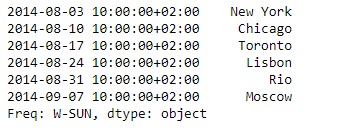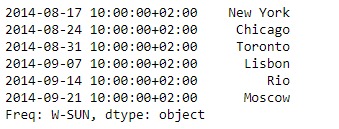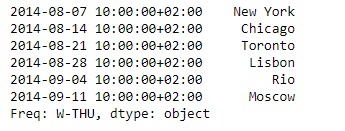Pandas 係列是帶有軸標簽的一維ndarray。標簽不必是唯一的,但必須是可哈希的類型。該對象同時支持基於整數和基於標簽的索引,並提供了許多方法來執行涉及索引的操作。
Pandas Series.tshift()函數用於移動時間索引,並使用時標的頻率(如果有)。如果未指定freq,則它將嘗試使用索引的freq或inferred_freq屬性。如果這些屬性都不存在,則會引發ValueError。
用法: Series.tshift(periods=1, freq=None, axis=0)
參數:
periods:移動的周期數,可以是正數或負數
freq:從tseries模塊或時間規則中使用的增量(例如“ EOM”)
axis:對應於包含索引的軸
返回:移動:NDFrame
範例1:采用Series.tshift()函數將給定係列對象的基於Datetime的索引移動一定的時間。
# importing pandas as pd
import pandas as pd
# Creating the Series
sr = pd.Series(['New York', 'Chicago', 'Toronto', 'Lisbon', 'Rio', 'Moscow'])
# Create the Datetime Index
didx = pd.DatetimeIndex(start ='2014-08-01 10:00', freq ='W',
periods = 6, tz = 'Europe/Berlin')
# set the index
sr.index = didx
# Print the series
print(sr)輸出:

現在我們將使用Series.tshift()函數將索引按係列對象已應用的頻率移動2個周期。
# shift by 2 periods
sr.tshift(periods = 2)輸出:

正如我們在輸出中看到的,Series.tshift()函數已成功將給定係列的基於DateTime的索引移動了2個周期。
範例2:采用Series.tshift()函數可將給定係列對象的基於DateTime的索引增加一定的時間,並在其上應用“每日”頻率。
# importing pandas as pd
import pandas as pd
# Creating the Series
sr = pd.Series(['New York', 'Chicago', 'Toronto', 'Lisbon', 'Rio', 'Moscow'])
# Create the Datetime Index
didx = pd.DatetimeIndex(start ='2014-08-01 10:00', freq ='W',
periods = 6, tz = 'Europe/Berlin')
# set the index
sr.index = didx
# Print the series
print(sr)輸出:

現在我們將使用Series.tshift()該函數可將序列對象已應用頻率上的索引增加4個周期。
# increment by 4 periods
sr.tshift(periods = 4, freq = 'D')輸出:

正如我們在輸出中看到的,Series.tshift()函數已成功將給定係列的基於DateTime的索引增加了4個周期。
相關用法
- Python pandas.map()用法及代碼示例
- Python Pandas Series.max()用法及代碼示例
- Python Pandas Series.min()用法及代碼示例
- Python Pandas.to_datetime()用法及代碼示例
- Python Pandas Dataframe.iat[ ]用法及代碼示例
- Python Pandas Series.dt.tz用法及代碼示例
- Python Pandas TimedeltaIndex.name用法及代碼示例
- Python Pandas Dataframe.pop()用法及代碼示例
- Python Pandas.melt()用法及代碼示例
- Python Pandas Series.lt()用法及代碼示例
- Python Pandas Timestamp.day用法及代碼示例
- Python Pandas Series.gt()用法及代碼示例
- Python Pandas Series.last()用法及代碼示例
- Python Pandas Series.ne()用法及代碼示例
- Python Pandas Series.ge()用法及代碼示例
注:本文由純淨天空篩選整理自Shubham__Ranjan大神的英文原創作品 Python | Pandas Series.tshift()。非經特殊聲明,原始代碼版權歸原作者所有,本譯文未經允許或授權,請勿轉載或複製。
